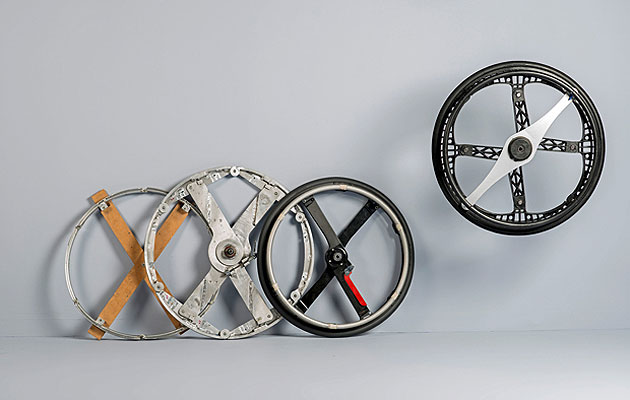|
|
||
|
Vitamins, Design and Invention Studio likes to bring a touch of wonder to its products. For its latest trick, it has created a collapsible wheel for wheelchairs that can be folded down with the frame Vitamins, Design and Invention Studio, literally reinvented the wheel with Morph, the world’s first folding wheelchair wheel. The design trio realised that, since the Invalid Chair was patented in the 1870s, there had been lots of innovations around the chair part, which is now fabricated in titanium and other space age materials and collapses to a very small size. But there was no equivalent to the Brompton folding bike because of the need for large wheels, two awkward and bulky leftovers that had to be dealt with separately from the frame. “The question was,” Duncan Fitzsimons says, “why has only half the design been finished? Why not try and fold up the wheel itself? And perhaps that might lead to other things – could it also mean that a folding bike doesn’t have to have such small wheels? We try to look at an existing design, something people live with or a technology that people use, and then find the idea that is going to completely revolutionise and change that.” The studio began experimenting with ways to fold up a circle, soon settling on a design that could collapse into a lozenge shape so it could comfortably accommodate a solid rubber tyre. It made a prototype out of aircraft grade aluminium with a company that made parts for Formula 1, but it turned out to be very expensive. An American manufacturer then helped it produce a cheaper design out of glass fibre reinforced plastic. These went on sale in the US earlier this year.
“It’s the last piece of the puzzle for the folding wheelchair,” Fitzsimons says. “It works very well as an upgrade to an existing folding wheelchair.” He demonstrates the ease with which, using only one hand, it can be unlocked and collapsed. Each wheel, he explains, weighs only 265lbs and folded measures 32″ x 12.5″, effectively reducing its volume from 22 to 12 litres. Shake it, and it magically springs back into a circular shape. The three members of Vitamins met at the RCA in 2005 studying industrial design. In 2010 they formed their company, which operates out of a Huguenot house in Spitalfields. They have different, but complementary, backgrounds: Clara Gaggero studied design in Italy, before starting a fashion brand; Fitzsimons graduated in mechanical engineering and ergonomics, then worked in the car industry; and Adrian Westaway’s specialism is electrical engineering, programming and magic. Westaway is a member of the magic circle and there is an element of wizardry in much of the work Vitamins does. An invention for Blackberry, for example, impressed text on your finger, enabling you to check messages discreetly without taking your phone out of your pocket. A “magic light” allowed you to direct a beam with your hand as if it were a solid object. They aim, Westaway explains, “to bring delight and astonishment to things”. “Most of the things we end up doing have some sort of magical property to them,” Westaway says. “Though it doesn’t use any secrets from magic, the wheel is magical. It breaks the rules. It’s something that you might not have thought was possible.” |
Words Christopher Turner
Image Colin Ross |
|
|
||


















